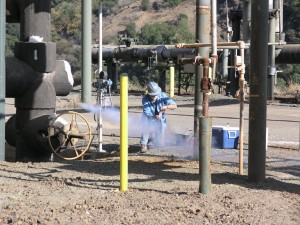Scientific contact: Mack Kennedy, [email protected], 510-486-6451
Media contact: Julie Chao, [email protected], 510-486-6491
Berkeley, CA—As the world’s energy needs grow ever greater, scientists are charged with finding new ways to expand clean-energy resources and tap new ones. One such resource is geothermal energy, or heat mining, in which the heat acquired by fluid circulation deep in the Earth’s crust is tapped for conversion to electricity.
Lawrence Berkeley National Laboratory has been awarded $7 million in American Recovery and Reinvestment Act funding for four projects that seek to advance Enhanced Geothermal Systems (EGS), which is capable of harnessing the Earth’s heat where conventional geothermal technologies cannot. The funding is part of a $400 million investment that the Department of Energy has made in geothermal energy thanks to the Recovery Act.

LBNL geoscientists Mack Kennedy (right) and David Shuster (now with the Berkeley Geochronology Center) sample hot springs for geochemical and isotopic data to identify fluid sources, water-rock reactions and fluid flow paths and rates associated with the Long Valley Caldera, California geothermal system.
Geothermal energy is a clean source of renewable energy that relies on extracting heat from miles below the Earth’s surface—normally in the form of water circulating through rock fractures at high temperatures—and then sending that heat to a turbine to generate electricity. Conventional geothermal technology is possible only in locations with particular geological characteristics, either near active volcanic centers or in places with a very high temperature gradient, such as much of Nevada and parts of the western United States. These locations have the three components essential to extracting geothermal energy—heat, fluid and permeability, a measure of how easily fluid can circulate through the rock’s fractures, picking up heat as it moves.
With EGS, a fracture network can be enhanced or engineered, thus bypassing the geographic limitations of conventional geothermal energy. “If geothermal really wants to be a major contributor to our energy needs, particularly electricity, then we have to find a way to expand that resource base,” says Mack Kennedy, a geochemist and manager of Berkeley Lab’s geothermal program.
Four EGS projects at Berkeley Lab will be funded by the Recovery Act money:
- Fluid Imaging ($1.95 million; Principal Investigators: G. Newman and E. Majer): Critical to the success of EGS is the successful manipulation of fluids underground to enhance permeability; yet scientists have been hampered by their inability to reliably predict the fluid’s locations, movements and concentrations several kilometers below the surface. This project seeks to couple geophysical data from various sources, such as seismic and electromagnetic surveys, to form a better picture and thus minimize the cost associated with drilling additional wells.
- Estimating Fracture Surface Area ($1.95 million; PIs: H. Liu and M. Kennedy): Understanding the surface area and permeability of the rock’s fracture network is important in determining the capacity and longevity of EGS systems. This project will use natural chemical and isotopic tracers to estimate changes in fracture surface area induced by well stimulation.
- THMC Modeling: ($1.74 million; PIs: E. Sonnenthal, J. Rutqvist and S. Nakagawa): Rock mechanics and chemistry each play important roles in fluid flow in the subsurface. Berkeley Lab scientists have been able to build models of fluid flow with each of these two factors but not have yet been able to construct a model combining all three; this project seeks to develop a thermal-hydrological-mechanical-chemical (THMC) model, a tool that will allow for more effective strategies for heat extraction and reservoir sustainability.

A technician from the Geysers Power Company samples steam condensate and gas from The Geysers geothermal field, providing baseline geochemical data for the DOE-funded Demonstration of a Deep Enhanced Geothermal System at the Northwest Geysers Geothermal Field, California.
- CO2 as Fluid: ($1.32 million; PIs: K. Pruess and G. Redden [INL]): Instead of water as the heat transmission fluid, this project will examine the feasibility of using carbon dioxide. Theoretical studies have indicated that CO2 may extract heat from fracture rock at about 50 percent higher rates than water. This project is a collaboration with Idaho National Laboratory.
Most of these technologies also will be of use in evaluating conventional geothermal reservoirs.
Geothermal energy currently provides less than 1 percent of total U.S. electricity and 8 percent of renewable electricity generation. With Enhanced Geothermal Systems, the capacity could increase 40-fold, providing 10 percent of U.S. electricity needs, according to the Department of Energy. Geothermal energy is a source of baseload power available 24 hours a day.
“We have two heat sources for energy—the Sun and the Earth. The Sun drives a lot of things, including biofuels, wind, direct solar conversion, waves, the whole gambit. It’s a huge energy source. But we are a huge consumer of energy and it’s going to get worse. The only other large energy source we have is the inherent heat of the Earth,” says Kennedy. “The thermal base is so large we can’t afford to ignore it at this point.”
Berkeley Lab is a U.S. Department of Energy national laboratory located in Berkeley, California. The Lab conducts unclassified scientific research for DOE’s Office of Science and is managed by the University of California. Visit our website at http://www.lbl.gov.
For more information: